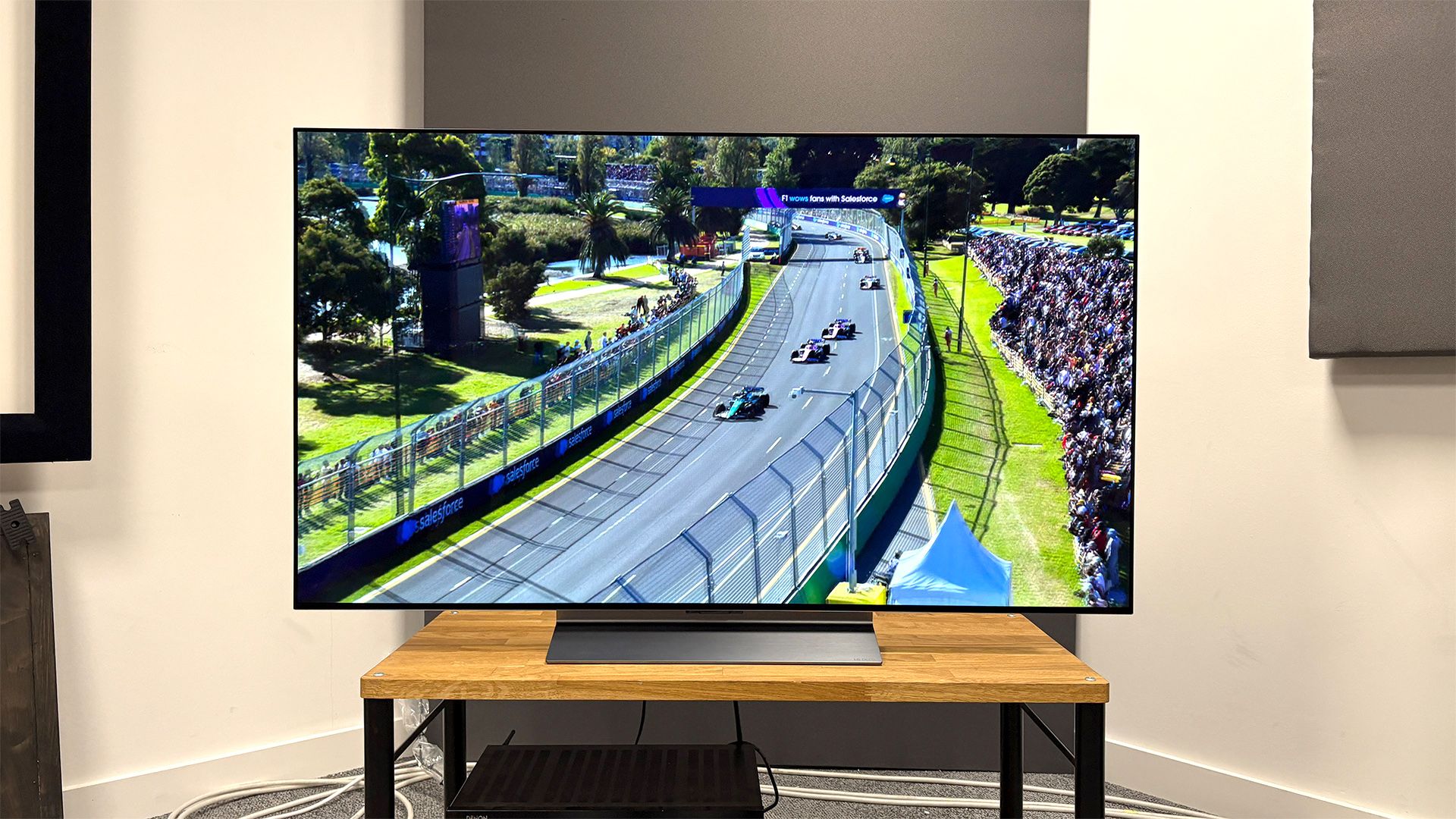Drinking coffee may protect people against irregular heartbeats, despite the conventional wisdom to the contrary, according to a new study.
The Does Eliminating Coffee Avoid Fibrillation (Decaf) clinical trial found 200 patients with persistent…

Drinking coffee may protect people against irregular heartbeats, despite the conventional wisdom to the contrary, according to a new study.
The Does Eliminating Coffee Avoid Fibrillation (Decaf) clinical trial found 200 patients with persistent…

Birthday wishes go out to Ellen Pompeo, Kiernan Shipka and all the other celebrities with birthdays today. Check out our slideshow below to see photos of famous people turning a year older on November 10th and learn an interesting fact about each…

LONDON – Rei Kawakubo, Adrian Joffe and Dickon Bowden will be recognized for their work at the groundbreaking retailer Dover Street Market during the Fashion Awards at London’s Royal Albert Hall on Dec. 1.
The trio will receive the…

Researchers at Trinity have developed a new platform for vaccine delivery they say could revolutionise treatment for respiratory infections.
Whooping cough (also known as pertussis) is a highly contagious…
This request seems a bit unusual, so we need to confirm that you’re human. Please press and hold the button until it turns completely green. Thank you for your cooperation!

Pseudomonas aeruginosa is ubiquitous in nature and a well-known opportunistic pathogen in hospitalized immunocompromised patients. P. aeruginosa can infect a range of systems and tissues, causing various types of inflammation and infections such as bacteremia, septicemia, septic pyemia, pneumonia, bronchitis, diarrhea, keratitis, and skin and wound infections.1,2 Multidrug-resistant P. aeruginosa poses a serious clinical threat, and the development of carbapenem resistance is expected to exacerbate this situation.3 Carbapenem-resistant P. aeruginosa (CRPA) has been categorized as a high-priority threat by the World Health Organization’s updated bacterial priority pathogen List (BPPL) 2024.4
Resistance to carbapenems in P. aeruginosa is generally due to a combination of mechanisms, including deficiency of the OprD porin, overexpression of efflux pumps, intrinsic chromosomally encoded AmpC β-lactamase, and production of carbapenemase.2,5,6 The production, activity, transferability, and prevalence of metallo-β-lactamases (MBLs), particularly members of imipenem-type and Verona integron-encoded MBL families, are the most clinical significance.7 A P. aeruginosa strain carrying the MBL-coding gene blaIMP-45, which was first reported in 2014, was isolated from a canine in Beijing.8 Recently, 23 blaIMP-45-carrying conjugative IncP-2 megaplasmids, carried by Pseudomonas spp. from diverse genetic backgrounds, have been reported worldwide.8–19 Among them, P. aeruginosa clone ST508 caused an outbreak of nosocomial infections at Hospital HS (Shanghai, China) from January to September 2015.12
Heteroresistance, which can generally be defined as the presence of subpopulations of cells within a culture of a single bacterial isolate with higher levels of antibiotic resistance, is a phenomenon that causes unreliability in antimicrobial susceptibility testing.20 It is widely accepted that heterogeneous resistance arises from the unstable amplification of resistance genes, likely involving complex interactions between mobile genetic elements, including plasmids, resistance gene cassettes, transposons, and insertion sequences. Heteroresistance to carbapenem has been well-documented in current clinical isolates of Escherichia coli, Klebsiella pneumoniae and Acinetobacter baumannii.21–23 Few studies have investigated the mechanisms of carbapenem-heteroresistant P. aeruginosa, which have shown the involvement of reduced OprD porin expression, efflux pump system overexpression, and biofilm formation.24 The mechanisms by which MBLs and MBL-harboring plasmids mediate carbapenem-resistant P. aeruginosa remain unclear.
This study pioneers the exploration of imipenem resistance mechanisms in P. aeruginosa mediated by MBLs-encoding genes and their plasmid-borne transmission pathways.Heterogeneous resistant strains carrying the blaIMP-45 gene showed a 32-fold increase in the maximum permissible growth concentration of 256 compared to non-heterogeneous resistant strains not carrying blaIMP-45. The maximum allowable growth concentration of 256 was 32-fold higher in the former than in the latter and 2-fold higher in the latter than in the heterogeneously resistant strain carrying blaIMP-45. Plasmid sequencing analysis showed that the genetic environment of blaIMP-45 was consistent, and there was no variation in the promoter region. Pre-exposure of the strains to a low concentration of imipenem for 24h caused an increase in the expression and copy number of blaIMP-45 in the heterogeneous resistant strains HN232 and HN41, except that the increase was more pronounced in the former.
The following non-duplicate clinical P. aeruginosa isolates were obtained from sputum or wound secretion samples collected mainly from two different surgical wards at the People’s Hospital of Sanya City, Hainan Province, between 2013 and 2014: HN41, HN66, HN67, HN125, HN148, and HN232. Bacterial species were initially identified using matrix-assisted laser desorption ionization-time-of-flight mass spectrometry (MALDI-TOF; Bruker,Germany). The criterion for strain inclusion was (IMP) readings of 1–3 mg/L (described below).
Genomic DNA was extracted using a Wizard Genomic DNA Purification Kit (Promega, Madison, WI, USA) and sequenced on an advanced Illumina NovaSeq 6000 platform.A double-ended 150 bp (PE150) strategy was adopted. Average sequencing depth of andgt;100 × per sample, data volume of ≥6 GB, QC requirements: Q30 >85% (base-balanced library), and compliance with Illumina standard QRP39. Raw data was QC controlled by FastQC v0.12.1 and low-quality reads (Phred score andlt;20) and adapter sequences were filtered using Trimmomatic v0.39. The resistance gene profiles of the strains were analyzed using ResFinder (http://genepi.food.dtu.dk/resfinder) and multilocus sequence typing (MLST) was performed using the tool available at https://cge.food.dtu.dk/services/MLST/. Species identification was confirmed using SpeciesFinder at the Center for Genomic Epidemiology (http://genomicepidemiology.org/services/).
Antimicrobial susceptibility testing was performed using the broth microdilution method with customized microtiter plates containing vacuum-dried antibiotics (BD,Phoenix NMIC-413, USA). The MIC values were interpreted according to the 2024 Clinical and Laboratory Standards Institute (CLSI) guidelines.25 E. coli strain ATCC 25922 was used as a quality control. Initial screening of HR strains was conducted using E-test strips (BioMérieux, France). Suspicion of heterogeneous resistance was based on the presence of resistant clones inside the zone of inhibition or unclear boundaries.
Bacterial suspensions containing 10−8–10−4 colony-forming units (CFU)/mL were prepared from a 0.5 McFarland standard (~ 0.1×108 CFU/mL). A 100-μL aliquot of each bacterial suspension was spotted in triplicate onto fresh gradient-diluted Mueller-Hinton agar (MHA) plates containing IMP at the following concentrations: 0, 0.5, 1, 2, 4, 8, 16, 32, 64, 128, 256, 512, and 1024 mg/L. The plates were incubated at 37°C for 24h and the number of CFUs at each concentration was used to draw the PAP curves. The analysis was performed in triplicate with carbapenem-susceptible P. aeruginosa ATCC27853 as the control strain.26
To investigate the effect of different IMP pre-exposure concentrations on the frequency of resistant clones, five different pre-exposure concentrations of IMP (0.5, 1, 4, 32, and 128 mg/L) were added to bacterial suspensions of HN232 activated for growth in Mueller-Hinton broth (MHB) and incubated for 24h at 37°C. Pre-exposure to 0 mg/L IMP served as a negative control. A 100 μL aliquot of each bacterial suspension was spotted in triplicate onto fresh gradient-diluted Mueller-Hinton agar (MHA) plates containing IMP at the following concentrations: 0, 0.5, 1, 2, 4, 8, 16, 32, 64, 128, 256, and 512 mg/L. The plates were incubated at 37°C for 24h and count the number of CFUs at each concentration (Figure 1). The analysis was performed in triplicate. The percentage of bacterial regrowth to IMP was calculated by dividing the number of CFUs on the IMP-containing MHA plates by the number of CFUs on the MHA plates without IMP.27
|
Figure 1 Pre-exposed with IMP to measure HN232 resistance frequency.
|
The complete genomes of HN232 and HN41 were sequenced by combining the data obtained from a whole-genome shotgun strategy using the Ion Torrent Personal Genome Machine system (Life Technologies, USA) and Pacific Biosciences RSII DNA sequencing platform (PacBio, USA). The contigs were assembled using the Hierarchical Genome Assembly Process version 3.0. Sequence annotation, open reading frame prediction, and pseudogene identification of plasmids were performed using RAST 2.0 (https://rast.nmpdr.org/). Annotation of resistance genes, mobile elements, and other features was carried out using the following online databases: ResFinder (http://genepi.food.dtu.dk/resfinder), ISfinder (https://www-is.biotoul.fr/index.php), INTEGRALL (http://integrall.bio.ua.pt/?) and the Tn Number Registry (http://www.ucl.ac.uk/eastman/research/departments/microbial-diseases/tn). Gene organization diagrams were constructed using Inkscape 0.48.1 (http://inkscape.org).
To study the effect of local amplification of plasmid-derived blaIMP-45 on the development of heterogeneous drug resistance, the IMP-HR strains HN232 and HN41 were treated with different pre-exposure concentrations of IMP. qRT-PCR was used to examine the expression of blaIMP-45, replication initiation protein A (repA), and the chromosomal housekeeping gene ecfX. The mRNA levels of blaIMP-45 and repA were expressed as fold-increases relative to that of ecfX, which served as the control.
For each strain, three independent cultures were exposed to a gradient of six IMP concentrations. After a 24h pre-exposure, the cultures were grown in MHB. The bacteria were collected and total RNA was extracted using an RNeasy R Mini Kit (Qiagen, Germany). The RNA sample concentrations were measured using a NanoDrop ND-1000 spectrophotometer. Reverse transcription of RNA was performed using the Prime Script RT Reagent Kit (Takara Bio, Japan) in accordance with the manufacturer’s instructions. The incubation conditions for cDNA synthesis were 37°C for 15min, 85°C for 5min, and 4°C for 5min. Primers for the amplification of blaIMP-45, plasmid-derived repA and ecfX were designed using the online tool (https://sg.idtdna.com/. All real-time PCRs were performed using a Bioer Quant Gene 9600 device. Each qRT-PCR reaction contained 5 µL 2 × SYBR Green (TIANGEN, China), 0.5 µL forward and reverse primers, 1 µL cDNA, and 3 µL RNase-free ddH2O (Takara Bio, Japan). The cycling parameters were as follows: 95°C for 20s, followed by 40 cycles of 95°C for 10s, 55°C for 10s, and 72°C for 20s. Relative gene expression was calculated using the 2−ΔΔCt method. At least three biological and technical replicates were performed for each set of experiments. The primers used are listed in Table S in supplementary material.
To study the copy numbers of blaIMP-45 and repA in HN232 and HN41, ddPCR assays comprising of three reactions were performed. The reaction system comprised 10 µL of 2×ddPCR Supermix for Probes (no dUTP) (Bio-Rad, USA), 4 µL of template DNA, 0.4 µL of forward and reverse primers, 0.4 µL of probe, and 4.8 µL of ddH2O, in a final reaction volume of 20 µL. Microdroplets of oil-encapsulated bacteria were generated using an automated microdroplet generator (Bio-Rad). Thermal cycling conditions using a Bio-Rad C1000 Touch™ Thermal Cycler were 95°C for 30s; 40 cycles at 95°C for 30s and 60°C for 30s; 98°C for 10min; and 4°C for 5min. The reaction data were examined using a QX200™ Droplet Analyzer and Bio-Rad Quanta Soft software for Poisson distribution analysis and calculation of absolute copy numbers. At least three biological and technical replicates were performed for each set of experiments. The primers used are listed in Supplementary material in Table S.
The complete sequences of HN41 chromosome, pHN41-MDR, HN232 chromosome, and pHN232-MDR were submitted to GenBank under accession numbers CP173219, CP173220, CP151543, and CP151544, respectively.
Among the six CRPA isolates, two belonged to the same sequence type ST (ST446), whereas the remaining four had unique STs, namely ST110, ST111, ST2631, and ST693.
All six strains were susceptible to aztreonam and colistin and resistant to cephalosporins, including ceftazidime, cefepime, and others including piperacillin/tazobactam, and meropenem. However, these strains showed varying degrees of sensitivity and resistance to IMP, fluoroquinolones (ciprofloxacin and levofloxacin) and amikacin. Regarding the response to IMP, HN66 and HN67 exhibited sensitivity, HN125 and HN232 showed intermediate susceptibility, and HN41 and HN148 exhibited resistance. All six strains showed MICs of 1–3 mg/L IMP on E-test strip readings (Table 1), with either fuzzy borders or visible colonies scattered within the inhibition zone (Supplementary material: Figure S), and were suspected to be IMP-heterogeneous.
 |
Table 1 Characteristics of Six P. Aeruginosa Clinical Isolates Carrying blaIMP-45
|
Regarding the antibiotic resistance genotype, strains HN67 and HN125 were negative for blaIMP-45 and positive for the presence of five resistance genes: aminoglycoside-3’-phosphotransferase gene aph (3’)-IIb, blaOXA-486/395/488/50/485, blaPAO-1, fosfomycin fosA, and catB7. These five genes were shared by all six isolates (excluding certain single-nucleotide polymorphisms within bla486/395/488/50), suggesting that they were chromosomally located intrinsic resistance genes. Among the four blaIMP-45-positive isolates, HN148 was found to carry a multidrug resistance operon and the following 14 resistance genes: rifampin gene arr-2; β-lactam genes blaOXA-485, blaPAO, blaIMP-45 and blaOXA-1; aminoglycoside genes aph (3’)-Ilb and aac (6’)-Ib3, chloramphenicol genes catB3 and catB7, fosfomycin gene (fosA), tetracycline gene cluster oprJ-tmexCD3, quinolone gene qnrVC1, trimethoprim gene dfrA22, and sulfonamide gene sul1. Compared with HN148, HN232 carries four additional resistance genes: aminoglycoside resistance gene armA, aph (3’)-Ia, macrolide-specific efflux pump gene msr(E), and macrolide phosphotransferase gene mph(E). Compared to HN232, HN66 and HN41 carried tet(C) and ciprofloxacin resistance protein-encoding crpP.
The heteroresistance non-inhibitory concentration (HNIC), heteroresistance inhibitory concentration (HIC), HIC/HNIC ratio, and frequency of resistant clones at the HNIC of IMP for the six isolates were determined using the PAP test (Table 2). Based on the classical definition of heteroresistance (presence of a subpopulation of resistant bacteria at ≥ 10−7 frequency that can grow in an antibiotic concentration ≥ 8-fold higher than the highest concentration affecting the growth of the main population),28,29 strains HN66, HN148, and HN232 were classified as IMP-HR, HN41, HN67and HN125 as IMP-NHR (Figure 2).
 |
Table 2 Validation of the Heteroresistant Status of P. Aeruginosa Strains Using the PAP Method
|
 |
Figure 2 Population analysis profile (PAP) curves of six P. aeruginosa strains to IMP. Abbreviations: CFU, colony-forming units; HR, heterogeneous resistance; NHR, non-heterogeneous resistance.
|
Notably, in strains HN67 and HN125, which did not carry blaIMP-45, the IMP HICs were 8 mg/L. In contrast, four of the blaIMP-45-positive strains, HN41, HN148, HN66, and HN232, exhibited HICs that were significantly elevated by at least 32-fold (≤ 256 mg/L) compared to HN67 and HN125.
As shown in Figure 3, at pre-exposure IMP concentrations of 1, 4, and 32 mg/L, the regrowth percentage and frequency of HN232 on plates containing a range of IMP concentrations showed an overall trend of initially increasing and then decreasing; however, they remained higher than those of the controls. At lower (0.5 mg/L) and higher (128 mg/L) IMP concentrations, the effect of pre-exposure on regrowth was not significant. The HICs of IMP for HN232 after pre-exposure to 0.5, 1, 4, 32, and 128 mg/L were 256, 256, 256, 128, and 128 mg/L, respectively, consistent with the HIC observed in the PAP experiment without pre-exposure. These results indicated that pre-exposure treatment did not affect HIC, but selectively increased the aggregation of resistant subpopulations at specific concentrations of IMP.
 |
Figure 3 Impact of pre-exposure to IMP on the formation of IMP-resistant subpopulations. Schematic diagram illustrating the pre-exposure of HN232 to different doses of IMP-containing liquid medium for 24 h followed by regrowth on Mueller-Hinton agar plates containing a gradient of IMP concentrations (0–512 mg/L). The percentage of bacterial strains regrowing on IMP plates at different concentrations. Experiments were independently repeated three times. Error bars represent the standard error of the mean (n = 3).
|
At pre-exposure to 1 mg/L IMP, the frequencies of HN232 bacteria on regrowth plates (0.5, 1, 2, 4 and 8 mg/L IMP) were 7.3×10−6, 1.03×10−7, 9.2×10−6, 8.6×10−6, and 7.5×10−6, respectively. The percentage of bacteria regrown on these plates was > 1. At pre-exposure to 4 mg/L IMP, the percentages of regrowth bacteria on plates containing 0.5, 1, 2 and 4 mg/L IMP were also > 1, with frequencies of regrowth bacteria of 7.19×10−6, 7.79×10−6, 7.42×10−6, and 7.24×10−6, respectively. However, this effect was not as evident at a pre-exposure IMP concentration of 1 mg/L, indicating that exposure to low IMP concentrations (1 and 4 mg/L) was sufficient to generate an IMP-resistant subpopulation that grew on plates containing ≥ 4 mg/L IMP (intermediate resistance) within a relatively short period. At pre-exposure to 32 mg/L IMP, the percentages of HN232 bacteria on regrowth plates at 0.5 and 1 mg/L IMP were also > 1, with frequencies of 7.1×10−6 and 7.35×10−6, respectively. In contrast, at 128 mg/L pre-exposure, the percentage of regrowth bacteria across all plates was < 1, suggesting that high concentrations of IMP may exert bactericidal effects and cause toxicity, thereby inhibiting bacterial growth.
Genomic sequencing and assembly revealed the presence of 433,528-kb and 449,083-kb closed circular DNAs carrying blaIMP-45 in HN232 and HN41 strains, which were hereafter designated as pHN232-MDR and pHN41-MDR, respectively. Plasmid pHN232-MDR encompassed 96% of the pHN41-MDR sequence and shared 100% nucleotide identity in the overlapping region. Both plasmids possessed the core characteristics of IncP-2 group megaplasmids (> 300 kb in size), including genes essential for replication (repA2, 1188 bp) and partition (parB2-parAB), and gene clusters coding for conjugation (tra), pilus assembly (pil), chemotaxis (che), and tellurium resistance (ter) functions in the plasmid backbone (data not shown).
The genetic environment adjacent to blaIMP-45 in both HN232 and HN41 was found to be associated with Tn1403-based Tn6485-like transposons (Figure 4). Tn1403 is a Tn3-family transposon that was initially identified in a clinical P. aeruginosa isolate from the USA in the 1970s.30 It has a core backbone composed of inverted repeat left (IRL), tnpA (transposase), tnpR (resolvase), res (resolution site), sup (sulfate permease), uspA (universal stress protein), dksA (RNA polymerase-binding transcription factor), yjiK (hypothetical protein), and inverted repeat right (IRR), with insertion sequence elements In28 and Tn5393c inserted into res and dksA, respectively. Tn1403 and its close derivatives Tn6060, Tn6061, Tn6217, Tn6249, and Tn6286,19,31–33 and the recently reported Tn6485a-h in Pseudomonas, often contain insertions of different foreign entities (eg, integrons and other transposons),9,12,15,16 serving as important vehicles for the transmission of resistance genes.
 |
Figure 4 Genetic environment of blaIMP-45 in pHN232-MDR and pHN41-MDR, and comparison with Tn1403. Genes are denoted by arrows. Colors of genes, mobile elements and other features indicate their functional classification. Shading denotes regions of homology (> 95% nucleotide identity). Numbers in brackets indicate the nucleotide positions within the corresponding plasmids. Pchybrid 1 (PcH1) and P2 promotors within In786.
|
Tn6485-like transposon Tn7445, found in both pHN232-MDR and pHN41-MDR, was 32,724 bp in length, with 38-bp IRLs and IRRs identical to those of Tn1403 and bordered by the same 5-bp TCTCA direct repeat, that is, target site duplications that indicate acquisition of Tn7445 by transposition. Compared to Tn1403, Tn7445 undergoes several biological events.
In the IMP-HR strain HN232, following pre-exposure to 1, 2, 8, 32, 128, and 512 mg/L IMP for 24h, the expression levels of repA relative to those of ecfX (1.36-, 1.23-, 1.17-, 0.96-, 0.73-, and 0.38-fold, respectively) suggested that plasmid replication was slightly induced at concentrations ≤ 8 mg/L, but was inhibited at concentrations ≥ 32 mg/L (Figure 5A). The expression levels of blaIMP-45 relative to those of ecfX in the same range of IMP concentrations (20.00, 3.95, 1.59, 1.31, 1.03, and 0.53-fold, respectively) indicated that blaIMP-45 expression might be induced by pre-exposure to ≤ 8 mg/L IMP, especially at 1 and 2 mg/L.
 |
Figure 5 Quantitative real-time PCR and droplet digital PCR analyses of blaIMP-45 in strains HN41 and HN232. (A and B) Expression of blaIMP-45 and repA relative to ecfX in IMP-HR strain HN232 and IMP-NHR strain HN41 exposed to various concentrations of IMP. (C) Copy numbers of blaIMP-45 and repA in HN232 and HN41 exposed to various concentrations of IMP. Experiments were independently repeated three times. Error bars represent the standard error of the mean (n = 3).
|
In IMP-NHR strain HN41, following exposure to 1, 2, 8, 32, 128, and 512 mg/L IMP, the expression levels of repA relative to those of ecfX (0.77-, 0.48-, 0.23-, 0.16-, 0.08-, and 0.02-fold) suggested that plasmid replication was inhibited at all concentrations, especially at ≥ 8 mg/L (Figure 5B). The expression levels of blaIMP-45 relative to those of ecfX at the same range of IMP concentrations (0.95-, 0.6-, 0.2-, 0.1-, 0.07-, and 0.02-fold, respectively) suggested that pre-exposure to 1 and 2 mg/L slightly increased the expression of blaIMP-45, all IMP concentrations inhibited the replication of the plasmid itself and the expression of blaIMP-45, especially at concentrations ≥ 8 mg/L.
The absolute copy numbers of blaIMP-45 and repA in HN232 and HN41 under pre-exposure IMP concentrations of 1 mg/L, 128 mg/L, and 512 mg/L were determined using ddPCR (Figure 5C). While the ratio of blaIMP-45 to repA varied between 2.8–3.8, the greatest difference in absolute copy numbers was observed at 1 mg/mL IMP in HN232, in which the absolute copy number of blaIMP-45 exceeded that of repA by > 3,000 copies, providing strong evidence for the independent replication of blaIMP-45 resulting from unstable gene amplification. In HN41, the blaIMP-45 copy number was also considerably higher than that of repA, but was not induced to the same extent as in HN232.
The presence of carbapenemases often leads to an MDR phenotype in P. aeruginosa, with frequent reports of strains harboring the MBL gene blaIMP-45 in recent years.8,11,12,16,34,35 The STs of P. aeruginosa isolates include ST235, ST274, ST277, ST308, ST357, ST369, ST389, ST508, ST708, ST1420, and ST3014,8,12,15,16 among these, ST508 and ST463 are high-risk clones involved in nosocomial infection outbreaks. To the best of our knowledge, ST693 and ST2631 identified in this study are novel blaIMP-45-carrying STs in P. aeruginosa. Phenotypically, the MIC values of meropenem for the six P. aeruginosa strains in this study were all > 8 mg/L (Table 1), which is above the resistance breakpoint recommended by CLSI 2024.25 CRPA isolates are generally defined by resistance to ≥ one carbapenems with antipseudomonal activity (doripenem, IMP, or meropenem);36 therefore, all six of our strains were classified as CRPA. However, the four blaIMP-45-carrying strains showed different MIC values (≤ 0.25 to > 8 mg/L) for IMP (Table 1). This may be attributable to the different pharmacokinetic traits of IMP and meropenem; the anti-bactericidal activity and killing speed of IMP against P. aeruginosa are significantly greater than those of meropenem.37 Three of the blaIMP-45-carrying isolates (HN66, HN148, and HN232) were confirmed to be IMP-HR; however, whether these strains are also HR to meropenem requires further investigation.In one study, rates of CRPA heteroresistance to meropenem and IMP have been reported 72.5% and 54.3%, respectively, indicating variability.38
The results of PAP testing and IMP pre-exposure experiments revealed that the HIC of blaIMP-45-carrying IMP-HR isolates could be increased 32-fold (up to 256 mg/L) relative to that of blaIMP-45-negative IMP-HR isolates. Additionally, pre-exposure of the strains to low concentrations of IMP (1 and 4 mg/L) led to an increased frequency of regrowth on plates containing IMP concentrations associated with intermediate susceptibility and resistance. Both factors could contribute to the difficulty in completely eradicating IMP-HR strains during clinical treatment, thereby increasing the likelihood of infections evolving into refractory infections and treatment failure.
Examination of the genetic environment of blaIMP-45 in the CRPA isolates revealed that this gene is located in the second gene cassette of In786 within the Tn1403-derived transposon, which resides in the Inc-P2 megaplasmid. The expression of blaIMP-45 was governed by the same promoter in both IMP-HR HN232 and IMP-NHR HN41, excluding the possibility that the observed variation in gene expression levels was due to genetic and environmental differences. In contrast to the high genetic diversity of the genetic background of host strains, the genetic environment of blaIMP-45 is relatively monotonous. Except for two cases of blaIMP-45 found on the chromosomes of P. aeruginosa strains PA59 and M140A,39 all the fully sequenced blaIMP-45-carrying plasmids belonged to the IncP-2 group. Prior to 2013, the blaIMP-45-encoding plasmid pOZ176 (500 kb) was the only fully sequenced IncP-2 plasmid with blaIMP-45 residing in the second gene cassette located within In244 (aacA4’-blaIMP-9–aacA4’).8 Subsequently, in 2017 and 2018, two IncP-2 plasmids, pSY153-MDR18 and pBM413,16 were reported in Pseudomonas putida and P. aeruginosa, respectively. Both were shown to carry blaIMP-45 (the G214S variant of blaIMP-9) in In786. To date, at least 23 blaIMP-45 plasmids have been reported,8–19 and phylogenetic analysis has revealed that most plasmids carrying blaIMP-45 cluster into a distinct sublineage that also contains the full pOZ176 sequence, facilitating the dissemination of blaIMP-45 among genetically diverse P. aeruginosa strains.Despite all carrying the identical blaIMP-45 gene, the isolates displayed ≥ 32-fold variation in imipenem MICs (each exceeding the clinical resistance breakpoint).This divergence, in the absence of any promoter or cassette polymorphism, indicates that the variable resistance levels are not encoded by the carbapenemase itself but are driven by the following mechanisms:inducible local amplification of the gene, differential plasmid replication control, and additional non-specific resistance traits such as efflux-pump overexpression.
In-depth mechanistic experiments indicated that plasmid replication in the IMP-NHR strain HN41 was suppressed at all IMP concentrations compared with chromosomal replication. In contrast, in the IMP-HR strain HN232, plasmid replication was inhibited at high concentrations of IMP but was roughly equivalent to chromosomal replication at concentrations between 1 and 32 mg/L. A common feature observed in both strains was the increased expression of blaIMP-45 at IMP concentrations of 1 and 2 mg/L, with the fold increase being more pronounced in the HR strain. Absolute copy number quantification of blaIMP-45 and repA using ddPCR further revealed that low concentrations of IMP induced an increase in blaIMP-45 copy number in both HR and NHR isolates, albeit to a greater extent in the IMP-HR strain HN232. These findings support the hypothesis that blaIMP-45 can undergo localized, unstable gene amplification independent of plasmid replication, leading to increased gene copy number and expression, which may play a major role in heteroresistance. Additionally, these findings suggest that plasmid replication and localized amplification of blaIMP-45 are regulated by complex factors in both the strains. In comparison, plasmid replication and copy number may be more tightly controlled in IMP-NHR strain HN41.
Mobile genetic elements, such as IS26 and transposons, have been reported to mediate the unstable amplification of adjacent antibiotic resistance genes. Wei et al reported that after pre-exposure to sublethal doses of meropenem or tobramycin, IS26 mediated rapid and stable amplification of blaKPC-2, leading to carbapenem resistance in clinical E. coli strains.27 In A. baumannii, amplification of five resistance genes within the aadB region of plasmids has been reported to cause heteroresistance to tobramycin.13 Similarly, in Salmonella enterica serovar Typhimurium, gene amplification at the chromosomal pmrD locus is associated with heteroresistance to colistin.12 Whether the unstable downstream amplification of blaIMP-45 observed in our study was driven by IS26 or a Tn1403-like transposon remains to be confirmed.
While this study provides compelling evidence for the role of the blaIMP-45-bearing plasmid and its inducible amplification in driving IMP heteroresistance in P. aeruginosa, it is important to acknowledge a potential limitation regarding the temporal scope of the isolates investigated. The clinical strains analyzed in this work were collected between 2013 and 2014. Antimicrobial resistance profiles and the prevalence of specific resistance mechanisms, including carbapenemases like IMP variants, are known to evolve dynamically over time in response to selective antibiotic pressure and infection control practices. Consequently, the specific resistance landscape and the relative abundance of blaIMP-45 or similar determinants observed in this cohort may not fully represent the current clinical epidemiology of P. aeruginosa carbapenem resistance or the predominant mechanisms underpinning heteroresistance in contemporary settings. Future studies incorporating more recent clinical isolates would be valuable to confirm the ongoing relevance of the plasmid-mediated amplification mechanism described here and to assess potential shifts in the genetic drivers of IMP heteroresistance.
Carbapenem antibiotics remain the first-line treatment for P. aeruginosa infection. IncP-2 conjugative megaplasmids still serve as predominant vehicles for the dissemination of blaIMP-45 among P. aeruginosa isolates. Our results indicate that, in IMP-HR blaIMP-45-carrying P. aeruginosa, short-term (24 h) exposure to IMP concentrations as low as 1 mg/L can induce unstable localized gene amplification of plasmid-derived blaIMP-45 in the frequency of occurrence of resistant sub populations. These findings emphasize the importance of rational antibiotic use in clinical treatment.
Human specimens were acquired with the patient’s consent. The use of human specimens and all related experimental protocols was reviewed and approved by the Ethics Committee of the National Institute for Communicable Disease Control and Prevention, Chinese Center for Disease Control and Prevention, in accordance with the medical research regulations of the Ministry of Health of China.The strain was routinely preserved in our laboratory repository, no patient interventions or additional sample collections were conducted. This study adhered to the guidelines outlined in the Declaration of Helsinki.
This study was supported by the National Natural Science Foundation of China (grant number: L2124006).
All authors made a significant contribution to the work reported, whether that is in the conception, study design, execution, acquisition of data, analysis and interpretation, or in all these areas; took part in drafting, revising or critically reviewing the article; gave final approval of the version to be published; have agreed on the journal to which the article has been submitted; and agree to be accountable for all aspects of the work.
The authors report no conflicts of interest in this work.
1. Si T, Wang A, Yan H. et al. Progress in the Study of Natural Antimicrobial Active Substances in Pseudomonas aeruginosa. Molecules. 2024;29(18):4400. doi:10.3390/molecules29184400
2. Alimoghadam S, Eslami A, Alimoghadam R, et al. The frequency of AmpC overproduction, OprD downregulation and OprM efflux pump expression in Pseudomonas aeruginosa: a comprehensive meta-analysis. J Global Antimicrob Resist. 2024;39:159–169. doi:10.1016/j.jgar.2024.08.014
3. Maiga A, Ampomah-Wireko M, Li H, et al. Multidrug-resistant bacteria quorum-sensing inhibitors: a particular focus on Pseudomonasaeruginosa. Eur J Med Chem. 2024;281:117008. doi:10.1016/j.ejmech.2024.117008
4. Jesudason T. WHO publishes updated list of bacterial priority pathogens. Lancet Microbe. 2024;5(9):100940. doi:10.1016/j.lanmic.2024.07.003
5. Wu W, Huang J, Xu Z. Antibiotic influx and efflux in Pseudomonas aeruginosa: regulation and therapeutic implications. Microb Biotechnol. 2024;17(5). doi:10.1111/1751-7915.14487
6. Ferous S, Anastassopoulou C, Pitiriga V, Vrioni G, Tsakris A. Antimicrobial and Diagnostic Stewardship of the Novel β-Lactam/β-Lactamase Inhibitors for Infections Due to Carbapenem-Resistant Enterobacterales Species and Pseudomonas aeruginosa. Antibiotics. 2024;13(3):285. doi:10.3390/antibiotics13030285
7. Tenover FC, Nicolau DP, Gill CM. Carbapenemase-producing Pseudomonas aeruginosa–an emerging challenge. Emerging Microbes Infect. 2022;11(1):811–814. doi:10.1080/22221751.2022.2048972
8. Wang Y, Wang X, Schwarz S, et al. IMP-45-producing multidrug-resistant Pseudomonas aeruginosa of canine origin. J Antimicrob Chemother. 2014;69(9):2579–2581. doi:10.1093/jac/dku133
9. Fang Y, Wang N, Wu Z, et al. An XDR Pseudomonas aeruginosa ST463 Strain with an IncP-2 Plasmid Containing a Novel Transposon Tn6485f Encoding bla(IMP-45) and bla(AFM-1) and a Second Plasmid with Two Copies of bla(KPC-2). Microbiol Spectrum. 2023;11(1):e0446222. doi:10.1128/spectrum.04462-22
10. Dong N, Liu C, Hu Y, et al. Emergence of an Extensive Drug Resistant Pseudomonas aeruginosa Strain of Chicken Origin Carrying bla(IMP-45), tet(X6), and tmexCD3-toprJ3 on an Inc(pRBL16) Plasmid. Microbiol Spectrum. 2022;10(6):e0228322. doi:10.1128/spectrum.02283-22
11. Wang N, Zheng X, Leptihn S, et al. Characteristics and phylogenetic distribution of megaplasmids and prediction of a putative chromid in Pseudomonas aeruginosa. Comput Struct Biotechnol J. 2024;23:1418–1428. doi:10.1016/j.csbj.2024.04.002
12. Zhang X, Wang L, Li D, et al. An IncP-2 plasmid sublineage associated with dissemination of blaIMP-45 among carbapenem-resistant Pseudomonas aeruginosa. Emerging Microbes Infect. 2021;10(1):442–449. doi:10.1080/22221751.2021.1894903
13. Urbanowicz P, Bitar I, Izdebski R, et al. Epidemic Territorial Spread of IncP-2-Type VIM-2 Carbapenemase-Encoding Megaplasmids in Nosocomial Pseudomonas aeruginosa Populations. Antimicrob Agents Chemother. 2021;65(4). doi:10.1128/AAC.02122-20.
14. Zhou D, Song Y, Dai E, et al. Plasmids of novel incompatibility group IncpRBL16 from Pseudomonas species. J Antimicrob Chemother. 2020;2020:1.
15. Zhang Y, Meng L, Guan C, Zhou Y, Peng J, Liang H. Genomic characterisation of clinical Pseudomonas aeruginosa isolate PAG5 with a multidrug-resistant megaplasmid from China. J Global Antimicrob Resist. 2020;21:130–131. doi:10.1016/j.jgar.2020.03.012
16. Liu J, Yang L, Chen D, et al. Complete sequence of pBM413, a novel multidrug resistance megaplasmid carrying qnrVC6 and bla IMP-45 from pseudomonas aeruginosa. Int J Antimicrob Agents. 2018;51(1):145–150. doi:10.1016/j.ijantimicag.2017.09.008
17. Zhou L, Yang C, Zhang X, et al. Characterization of a novel Tn6485h transposon carrying both blaIMP-45 and blaAFM-1 integrated into the IncP-2 plasmid in a carbapenem-resistant Pseudomonas aeruginosa. J Global Antimicrob Resist. 2023;35:307–313. doi:10.1016/j.jgar.2023.10.010
18. Yuan M, Chen H, Zhu X, et al. pSY153-MDR, a p12969-DIM-related mega plasmid carrying bla(IMP-45) and armA, from clinical Pseudomonas putida. Oncotarget. 2017;8(40):68439–68447. doi:10.18632/oncotarget.19496
19. Xiong J, Alexander DC, Ma JH, et al. Complete Sequence of pOZ176, a 500-Kilobase IncP-2 Plasmid Encoding IMP-9-Mediated Carbapenem Resistance, from Outbreak Isolate Pseudomonas aeruginosa 96. Antimicrob Agents Chemother. 2013;57(8):3775–3782. doi:10.1128/AAC.00423-13
20. Martínez-López N, Vilas C, García MR. A birth–death model to understand bacterial antimicrobial heteroresistance from time-kill curves. Math Biosci. 2024;376:1.
21. Shields RK, Dorazio AJ, Tiseo G, et al. Frequency of cefiderocol heteroresistance among patients treated with cefiderocol for carbapenem-resistant Acinetobacter baumannii infections. JAC-Antimicrob Resist. 2024;6(5). doi:10.1093/jacamr/dlae146.
22. Graffice E, Moates DB, Leal SM, Amerson-Brown M, Calix JJ. Epidemiological, Phylogenetic, and Resistance Heterogeneity Among Acinetobacter baumannii in a Large U.S. Deep South Healthcare system. Open Forum Infect Diseases. 2024;11(9). doi:10.1093/ofid/ofae458
23. Lin CK, Page A, Lohsen S, et al. Rates of resistance and heteroresistance to newer β-lactam/β-lactamase inhibitors for carbapenem-resistant Enterobacterales. JAC-Antimicrob Resist. 2024;6(2). doi:10.1093/jacamr/dlae048.
24. Xie X, Liu Z, Huang J, et al. Molecular epidemiology and carbapenem resistance mechanisms of Pseudomonas aeruginosa isolated from a hospital in Fujian, China. Front Microbiol. 2024;15. doi:10.3389/fmicb.2024.1431154
25. CLSIM100ED34-2024-Performance Standards for Antimicrobial Susceptibility Testing.pdf.
26. Li W-R, Zhang Z-Q, Liao K, et al. Pseudomonas aeruginosa heteroresistance to levofloxacin caused by upregulated expression of essential genes for DNA replication and repair. Front Microbiol. 2022;13. doi:10.3389/fmicb.2022.1105921
27. Wei DW, Wong NK, Song Y, et al. IS26 Veers Genomic Plasticity and Genetic Rearrangement toward Carbapenem Hyperresistance under Sublethal Antibiotics. mBio. 2021;13(1):e0334021. doi:10.1128/mbio.03340-21
28. El-Halfawy OM, Valvano MA. Antimicrobial Heteroresistance: an Emerging Field in Need of Clarity. Clin Microbiol Rev. 2015;28(1):191–207. doi:10.1128/CMR.00058-14
29. Nicoloff H, Hjort K, Andersson DI, Wang H. Three concurrent mechanisms generate gene copy number variation and transient antibiotic heteroresistance. Nat Commun. 2024;15(1). doi:10.1038/s41467-024-48233-0
30. Vézina G, Levesque RC. Molecular characterization of the class II multiresistance transposable element Tn1403 from Pseudomonas aeruginosa. Antimicrob Agents Chemother. 1991;35(2):313–321. doi:10.1128/AAC.35.2.313
31. Chowdhury PR, Merlino J, Labbate M, Cheong EYL, Gottlieb T, Stokes HW. Tn 6060, a Transposon from a Genomic Island in a Pseudomonas aeruginosa Clinical Isolate That Includes Two Class 1 Integrons. Antimicrob Agents Chemother. 2009;53(12):5294–5296. doi:10.1128/AAC.00687-09
32. Di Pilato V, Pollini S, Rossolini GM. Tn6249, a New Tn 6162 Transposon Derivative Carrying a Double-Integron Platform and Involved with Acquisition of the bla VIM-1 Metallo-β-Lactamase Gene in Pseudomonas aeruginosa. Antimicrob Agents Chemother. 2015;59(3):1583–1587. doi:10.1128/AAC.04047-14
33. Coyne S, Courvalin P, Galimand M. Acquisition of multidrug resistance transposon Tn6061 and IS6100-mediated large chromosomal inversions in Pseudomonas aeruginosa clinical isolates. Microbiology. 2010;156(5):1448–1458. doi:10.1099/mic.0.033639-0
34. Kang Y, Xie L, Yang J, Cui J. Optimal treatment of ceftazidime-avibactam and aztreonam-avibactam against bloodstream infections or lower respiratory tract infections caused by extensively drug-resistant or pan drug-resistant (XDR/PDR) Pseudomonas aeruginosa. Front Cell Infect Microbiol. 2023;13. doi:10.3389/fcimb.2023.1023948
35. Lin H, Feng C, Zhu T, et al. Molecular Mechanism of the β-Lactamase Mediated β-Lactam Antibiotic Resistance of Pseudomonas aeruginosa Isolated From a Chinese Teaching Hospital. Front Microbiol. 2022;13:1.
36. Walters MS, Grass JE, Bulens SN, et al. Carbapenem-Resistant Pseudomonas aeruginosa at US Emerging Infections Program Sites, 2015. Emerging Infectious Diseases. 2019;25(7):1281–1288. doi:10.3201/eid2507.181200
37. Dreetz M, Hamacher J, Eller J, et al. Serum bactericidal activities and comparative pharmacokinetics of meropenem and imipenem-cilastatin. Antimicrob Agents Chemother. 1996;40(1):105–109. doi:10.1128/AAC.40.1.105
38. He J, Jia X, Yang S, et al. Heteroresistance to carbapenems in invasive Pseudomonas aeruginosa infections. Int J Antimicrob Agents. 2018;51(3):413–421. doi:10.1016/j.ijantimicag.2017.10.014
39. Ma W, Guo J, Deng C, et al. Characterization of the Chromosomally Located Metallo-β-Lactamase Genes bla(IMP-45) and bla(VIM-2) in a Carbapenem-Resistant Pseudomonas aeruginosa Clinical Isolate. Microbial Drug Resistance. 2024;30(10):422–431. doi:10.1089/mdr.2024.0059
This request seems a bit unusual, so we need to confirm that you’re human. Please press and hold the button until it turns completely green. Thank you for your cooperation!

The Sony Bravia 8 II might be the best 65-inch TV of the year for pure performance, but the LG C5 trumps it for value. That’s truer now than ever before, as the C5 has hit its lowest ever price – it’s just £1499 at Richer Sounds.
That’s £100…

New studies from Arizona State University reveal surprising ways bacteria can move without their flagella — the slender, whip-like propellers that usually drive them forward.
Movement lets bacteria form communities, spread to new…